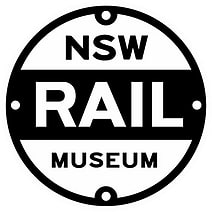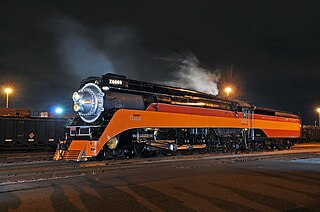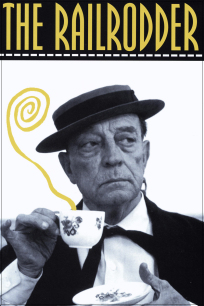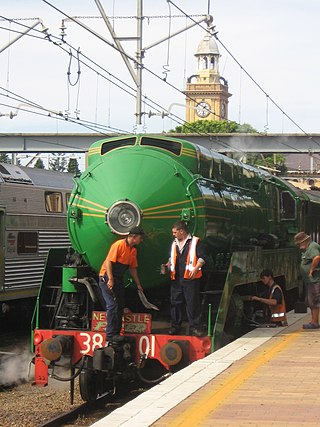
A steam locomotive is a locomotive that provides the force to move itself and other vehicles by means of the expansion of steam. It is fuelled by burning combustible material to heat water in the locomotive's boiler to the point where it becomes gaseous and its volume increases 1,700 times. Functionally, it is a steam engine on wheels.

The C38 class was a class of steam locomotive built for the New South Wales Government Railways in Australia.

The Titfield Thunderbolt is a 1953 British comedy film directed by Charles Crichton and starring Stanley Holloway, Naunton Wayne, George Relph and John Gregson. The screenplay concerns a group of villagers trying to keep their branch line operating after British Railways decided to close it. The film was written by T. E. B. Clarke and was inspired by the restoration of the narrow gauge Talyllyn Railway in Wales, the world's first heritage railway run by volunteers. "Titfield" is an amalgamation of the names Titsey and Limpsfield, two villages in Surrey near Clarke's home at Oxted.
The Cowan rail accident occurred at 7:20pm on 6 May 1990 when the 3801 Limited special steam passenger train returning from the Morpeth Jazz Festival was struck in the rear by the following CityRail inter-urban passenger service. The steam train had stalled while attempting to climb the steep gradient from the Hawkesbury River to Cowan, New South Wales, and it was found that sand applied to the rails to regain traction had interfered with the signals and given the following train a false clear indication.

A fireman, stoker or watertender is a person whose occupation it is to tend the fire for the running of a boiler, heating a building, or powering a steam engine. Much of the job is hard physical labor, such as shoveling fuel, typically coal, into the boiler's firebox. On steam locomotives the title fireman is usually used, while on steamships and stationary steam engines, such as those driving saw mills, the title is usually stoker. The German word Heizer is equivalent and in Dutch the word stoker is mostly used too. The United States Navy referred to them as watertenders.

The NSW Rail Museum is the main railway museum in New South Wales, Australia. A division of Transport Heritage NSW, it was previously known as the New South Wales Rail Transport Museum (NSWRTM), Rail Heritage Centre and Trainworks.

A train driver, engine driver, engineman or locomotive driver, commonly known as an engineer or railroad engineer in the United States and Canada, and also as a locomotive handler, locomotive engineer, locomotive operator, train operator, or motorman, is a person who operates a train, railcar, or other rail transport vehicle. The driver is in charge of and is responsible for the mechanical operation of the train, train speed, and all of the train handling. In American English, a hostler moves engines around rail yards, but does not take them out on the main line tracks; the British English equivalent is a shunter.

Southern Pacific 4449, also known as the Daylight, is the only surviving example of Southern Pacific Railroad's "GS-4" class of 4-8-4 "Northern" type steam locomotives and one of only two GS-class locomotives surviving, the other being "GS-6" 4460 at the National Museum of Transportation in St. Louis, Missouri. GS is an abbreviation of "General Service" or "Golden State," a nickname for California.

3801 is a 4-6-2 steam locomotive operated by the New South Wales Government Railways between 1943 and 1974. It is arguably Australia's most famous steam locomotive, being the only one to have visited all mainland states and territories.
The Ais Gill rail accident occurred on the Settle–Carlisle line in Northwest England on 2 September 1913. Two long trains were both ascending a steep gradient with some difficulty, because their engines generated barely enough power to carry the load. When the first train stopped to build up steam pressure, the driver and fireman of the second train were distracted by maintenance routines, and failed to observe the warning signals. The collision wrecked several carriages, which were then engulfed by flammable gas, killing 16 people and injuring 38.

Night Mail is a 1936 British documentary film directed and produced by Harry Watt and Basil Wright, and produced by the General Post Office (GPO) Film Unit. The 24-minute film documents the nightly postal train operated by the London, Midland and Scottish Railway (LMS) from London to Scotland and the staff who operate it. Narrated by John Grierson and Stuart Legg, the film ends with a "verse commentary" written by W. H. Auden to a score composed by Benjamin Britten. The locomotive featured in the film is LMS Royal Scot Class 6115 Scots Guardsman.

The Railrodder is a 1965 short comedy film starring Buster Keaton in one of his final film roles, directed by Gerald Potterton and produced by the National Film Board of Canada (NFB). A 25-minute comedic travelogue of Canada, The Railrodder was also Keaton's final silent film, as the film contains no dialogue and all sound effects are overdubbed.
Dean Semler ACS ASC is an Australian cinematographer and film director. Over his career, he has worked as a cinematographer, camera operator, director, second unit director, and assistant director. He is a three-time recipient of the AACTA Award for Best Cinematography and an Academy Award winner. He is a member of both the Australian Cinematographers Society (ACS) and the American Society of Cinematographers (ASC). In 2002 he was appointed a Member of the Order of Australia (AM).

Film Australia was a company established by the Government of Australia to produce films about Australia in 1973. Its predecessors were the Cinema and Photographic Branch (1913–38), the Australian National Film Board, and the Commonwealth Film Unit (1956–72). Film Australia became Film Australia Limited in 1988 and was consolidated into Screen Australia in 2008.

Casey Jones is an American Western television series syndicated during the 1957–58 television season. It was based upon the life of late 19th-century engineer Casey Jones in the era of pioneering western railroads. Casey Jones also aired on both the BBC and ITV in the United Kingdom and on the Seven Network in Australia.
Anthony Buckley AO is an Australian film producer and editor.

The Newcastle Flyer was an Australian passenger express train that operated from November 1929 until April 1988 connecting New South Wales' two largest cities, Sydney and Newcastle.

3112 is a preserved former New South Wales Government Railways C30 class steam locomotive built in 1914 by Beyer, Peacock & Company, England.

The Flying Scotsman is a 1929 British black and white part-silent film set on the Flying Scotsman train from London to Edinburgh, also featuring the famous locomotive LNER Class A3 4472 Flying Scotsman. Directed by Castleton Knight, the thriller is chiefly remembered for being the first acting role of Ray Milland, as well as for its daring stunts performed aboard the moving train.

Locomotive 5917 is a two-cylinder, simple, non-condensing, superheated, coal-fired, 2-8-2 ‘Mikado' steam locomotive and one of five D59 class locomotives that were preserved. As of June 2021, it is the main steam locomotive used for the Picnic Train, mainly running between Sydney and Kiama.
















